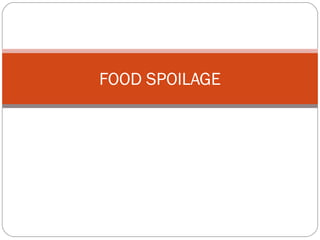
Signs and Types of Food Spoilage
- 2. FOOD SPOILAGE All food turns bad or spoilt after a certain period of time. Characteristics of spoilt food: 1. Unpleasant smell 2. Unpleasant taste 3. Change colour 4. Change texture 5. Mouldy
- 3. FOOD SPOILAGE FOOD CHARACTERISTIC Bread and cakes •Turns mouldy with black, green or white dots or hairy patches •Has unpleasant smell and taste •Become slimy Vegetables •Turn yellowish •Become soft and withered •Become slimy and watery Fruits •Become bruised •Turns mouldy •Has unpleasant smell and taste
- 4. FOOD SPOILAGE FOOD CHARCTERISTIC Fish and meat •Has unpleasant smell •Flesh becomes sunken when pressed •Has pale gills and sunken eyes in fish Milk •Smells and taste sour •Becomes curdled and foamy •Its has swells (bulges) Canned food •Tin can swells (bulges) •Food in it smells bad
- 5. FOOD SPOILAGE Food become rotten or decayed food Why? Due to the microorganism mainly bacteria and fungi Microorganism live and feed on the food. It breaks the food down into simpler substances. This process called decaying. When the food is decaying, it will smell and taste unpleasant and cause food poisoning when we eat. Microorganism need air, water, nutrients (food), moderate temperature and suitable acidity to grow.
- 7. FOOD PRESERVATION Involves treating food so it can be stored without spoiling for along time. Prevents or slow down the growth of microorganism on food. Killing the microorganism or making the condition unsuitable for them to growth and survival.
- 8. WASTE
- 9. TYPES OF WASTE Some waste can be decayed and some cannot be decayed The waste can be decayed by the microorganism is called biodegradable waste. The waste cannot be decayed by he microorganism is called non biodegradable waste Mostly biodegradable waste originated from living thing. For examples: 1. Discarded food, sewage, animal waste, paper and wood 2. Certain types of plastics known as biodegradable plastics and detergents known as biodegradable detergent. 3. Effluent from factory that produce food or processes agricultural product such as palm oil and rubber
- 10. Biodegradable Waste Decaying and decomposition is a process of breaking a material down into simpler substances by microorganism. The biodegradable waste changes like the following: 1. Change in appearance : It may change colour, become softer, become liquid or gas. 2. Reduction in size and volume : For example, a huge heap of dried leaves will be come small heap It can also be useful. The biodegradable waste can be used to make compost, nutrient-rich substance used as fertilisers.
- 11. Advantages and disadvantages of waste decay Advantages Allows nutrient in waste to be returned to the soil and be reused. Helps to reduce the volume of waste. Disadvantages Contribute to global warming Methane is produced by the global warming. Methane is a flammable gas. It will cause the landfill catch the fire easily especially during the hot and dry season. Rubbish and sewage treatment plants give out the bad smell.
- 12. Non Biodegradable Waste Non biodegradable waste remain in the environment for a very long time. It cannot be decayed easily. For example : The plastic bag takes about 10 to 20 years to decay. We should reduce the waste by reused and recycle them.
